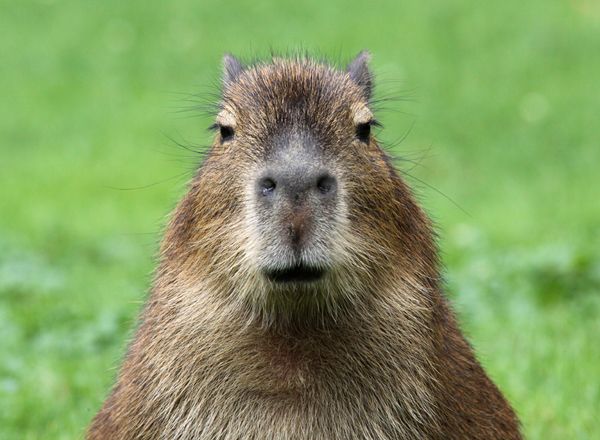Capybara Facts: Surprising Secrets About Nature’s Gentle Giant
Have you ever heard of the capybara? It’s not just any animal—it’s the world’s largest rodent, and it has some surprising traits that might just amaze you.
Whether you think of it as a giant guinea pig or a friendly water-loving creature, the capybara has unique habits and features you probably don’t know about. If you want to discover fun, fascinating, and even a little unexpected facts about this gentle giant, keep reading.
Your curiosity about nature is about to be rewarded!

Credit: www.youtube.com
Capybara Basics
Capybaras are unique animals that many people find fascinating. They are the largest rodents in the world. Understanding their basics helps appreciate these gentle creatures more.
Capybaras live in groups and enjoy social life. They are calm and friendly, making them interesting animals to study.
Physical Features
Capybaras have large, barrel-shaped bodies. Their fur is coarse and brownish. They have short legs and webbed feet. These features help them swim well. Their eyes, ears, and nose sit high on their heads. This helps them see and breathe while swimming.
Natural Habitat
Capybaras live near water bodies like rivers and lakes. They are native to South America. These animals prefer dense forests and grassy plains. Water is important for their survival and safety. They spend much time swimming and resting near water.
Diet And Eating Habits
Capybaras are herbivores. They eat grasses, aquatic plants, and fruits. Their teeth grow continuously to handle tough plants. They usually feed early in the morning and late in the evening. Capybaras chew their food slowly to digest well.

Credit: www.livescience.com
Social Behavior
Capybaras are very social animals. They live in groups and enjoy the company of others. Their social behavior helps them stay safe and find food. Understanding how capybaras interact gives us a glimpse into their daily lives.
Group Dynamics
Capybaras live in groups of 10 to 20 animals. These groups have a clear leader, usually a dominant male. The leader helps keep order and protects the group. Younger males often leave to find new groups. Females and their young stay close together. Group living helps capybaras avoid predators and share warmth.
Communication Methods
Capybaras use many sounds to talk. They bark, whistle, and purr to send messages. These sounds warn of danger or show friendliness. Body language is also important. They use nose touches and grooming to bond. Communication keeps the group connected and safe.
Interactions With Other Animals
Capybaras often share space with other animals. Birds sometimes ride on their backs to eat insects. Capybaras do not mind and stay calm. They also live near caimans and turtles. These animals rarely bother each other. Sharing space helps capybaras find food and stay alert.
Adaptations To Environment
Capybaras are well suited to their habitats. They live near water and dense forests. Their bodies have special traits that help them survive and thrive. These adaptations allow them to find food, stay safe, and keep comfortable in their environment.
Swimming Skills
Capybaras are excellent swimmers. Their partially webbed feet help them move through water easily. They can hold their breath underwater for up to five minutes. This skill helps them escape predators and find food in water plants.
Thermoregulation
Capybaras regulate their body temperature by using water and shade. They often rest in water to cool down during hot days. Their fur is thin, which helps heat escape quickly. At night, they become more active when temperatures drop.
Predator Avoidance
Capybaras stay alert to avoid predators. They use sharp senses to detect danger early. When threatened, they dive into water or run to thick vegetation. Living in groups also provides safety, as many eyes watch for threats.
Reproductive Life
Capybaras have a unique reproductive life that helps their species thrive. Their social nature influences mating and raising young. Understanding their reproductive habits reveals how they survive in the wild.
Mating Rituals
Capybaras live in groups with one dominant male. The male courts females through gentle nuzzles and soft sounds. Mating usually occurs in water, which helps them stay safe. The male guards his females to prevent rivals from mating. This behavior keeps the group stable and strong.
Gestation And Birth
The gestation period lasts about 150 days. Females give birth to a litter of four to five pups. Babies are born fully furred and with open eyes. They can walk and swim shortly after birth. This quick development helps them avoid predators.
Raising The Young
Both parents care for the pups, but the mother is most active. The group protects the young from danger. Pups nurse for up to 16 weeks but start eating grass early. They learn social skills by playing with siblings and others. This care ensures pups grow strong and healthy.
Capybaras And Humans
Capybaras share a special relationship with humans. These gentle creatures have caught human interest for many reasons. People admire their calm nature and unique behaviors. They appear in stories, homes, and conservation efforts. Understanding their role with humans helps us appreciate these animals more.
Cultural Significance
Capybaras appear in many South American cultures. They often symbolize peace and calm. Some indigenous groups respect them as part of nature’s balance. In art and folklore, capybaras represent harmony with the environment. Their presence in festivals and stories shows their cultural value.
Domestication And Pets
Some people keep capybaras as pets. They need large spaces and water to swim. Capybaras are social and bond well with humans. They require care and patience to thrive. Not all places allow capybaras as pets due to their special needs.
Conservation Status
Capybaras are not endangered but face habitat loss. Their wetlands and forests shrink due to farming and cities. Protecting their homes helps keep their numbers steady. Conservation groups work to preserve natural areas. Healthy habitats mean healthy capybara populations.
:max_bytes(150000):strip_icc()/GettyImages-528162130-53d0c5076eb14915ade61b5d3021294f.jpg)
Credit: www.treehugger.com
Fun And Surprising Facts
Capybaras are fascinating creatures with many surprising features. Their unique behaviors and traits make them stand out in the animal kingdom. Learning about these fun facts helps us appreciate capybaras more.
They are not just big rodents; they have many interesting qualities. Here are some fun and surprising facts about capybaras.
Unique Traits
Capybaras are the largest rodents in the world. They can grow up to 4 feet long and weigh over 140 pounds. Their webbed feet help them swim very well. They can stay underwater for up to five minutes. Capybaras have special teeth that grow continuously. This keeps their teeth sharp despite constant chewing.
Record Holders
Capybaras hold the record as the world’s largest rodent species. They can run surprisingly fast, reaching speeds up to 35 miles per hour. Their social groups can be very large, sometimes more than 20 individuals. Capybaras have one of the most relaxed and calm temperaments among wild animals.
Myths And Legends
Many myths surround capybaras in different cultures. Some say capybaras are magical animals that bring good luck. Others believe they can talk or predict weather changes. In some places, people think capybaras are water spirits. These stories show how special capybaras are to humans.
How Smart Pets Lover Can Help You with Capybara Facts
Connecting Capybara Facts with Practical Learning
Understanding capybaras’ social behavior and environmental adaptations offers more than just fascinating trivia—it opens doors for meaningful learning experiences. For instance, observing how capybaras thrive in groups can inspire us to appreciate the importance of community and social bonds in our own pets’ lives. Similarly, their unique adaptations to aquatic habitats remind us to create enriching, naturalistic environments for animals under our care, whether they’re furry, feathered, or finned.
At Smart Pets Lover, we believe every animal story enriches our connection with pets. Learning about capybaras’ reproductive life and their gentle interactions with humans encourages responsible and empathetic pet ownership—principles that apply broadly across all species. If you’re curious to explore further or share insights, reaching out to local wildlife experts or visiting reputable resources can deepen your understanding.
Remember, each discovery about animals like the capybara not only sparks joy but also equips us to be better, more compassionate caretakers—where every wag, purr, and chirp truly tells a story.
Frequently Asked Questions
What Do Capybaras Eat In The Wild?
Capybaras mainly eat grasses and aquatic plants. They also consume fruits and tree bark. Their diet is herbivorous and high in fiber. This helps them digest food efficiently in their natural habitat.
How Big Do Capybaras Grow?
Capybaras can grow up to 4. 3 feet long. They typically weigh between 77 to 146 pounds. They are the largest rodents in the world. Their size helps them stay safe from predators.
Are Capybaras Good Swimmers?
Yes, capybaras are excellent swimmers. They have webbed feet that help them move in water. They can stay submerged for up to five minutes. Water provides them protection and a place to find food.
Can Capybaras Live With Other Animals?
Capybaras are social and live in groups. They often coexist peacefully with birds and other animals. Their gentle nature makes them good companions in mixed habitats. This social behavior helps them stay alert.
Conclusion
Capybaras are unique and gentle animals loved by many. They live in groups and enjoy water very much. Their calm nature makes them special in the animal world. These facts help us understand capybaras better. Learning about them can bring us closer to nature.
They remind us to appreciate simple, peaceful moments. Keep exploring and discovering more about amazing creatures like capybaras.



